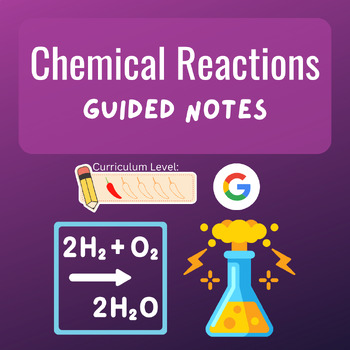Chemical Reactions Chapter - Guided Notes (Level 1: Regular, Merit, Foundations)
- PDF
- Google Apps™

Description
This set of Guided Notes includes a Google Slides presentation and a Google Doc with 2 weeks worth of fill-in-the-blank notes + additional practice pages. A PDF with my answer keys is also included. The student packet is easy to follow and goes directly with the presentation. The words the students need to fill in are bold and colorful on the presentation.
I like to project the pdf and then write directly on the document using my smartTV. I find this helps the students with their note-taking.
This set of notes covers the following topics:
- Chemical Reaction Symbols
- Writing Chemical Equations and Word Equations
- Balancing Chemical Reactions
- Identifying Types of Chemical Reactions: Synthesis, Decomposition, Single Replacement, Double Replacement, and Combustion
- Predicting Single Replacement Products
- Predicting Double Replacement Products
PLUS: A **BONUS** ... My Activity Series and Solubility Table Handout for Students
This set of guided notes is rated as a Curriculum Level 1 by the seller. Seller's ratings are as follows:
- 5 - AP, College
- 4 - PreAP, Honors, Dual Credit
- 3 - Honors, Accelerated
- 2 - Regular, Academic, College Prep
- 1 - Regular, Merit
**The difference between level 1 and level 2 is the general math ability of the class. Level 1 is for students in Algebra 1/are behind in math compared to grade-level peers. Level 2 is for students who have passed Algebra 1 and are on par with grade-level peers, though they may not love math class.
** Interested in my other Chemistry Resources?? - CLICK HERE **
--------------------------------------------
If you like what you see, check out the rest of my store and be sure to follow along to stay up to date on all new resources and sales! You can also follow me on Instagram.
Did you also know that by rating and reviewing a product, you can earn TpT credit? Be sure to let me know what you think... it really helps me out!





